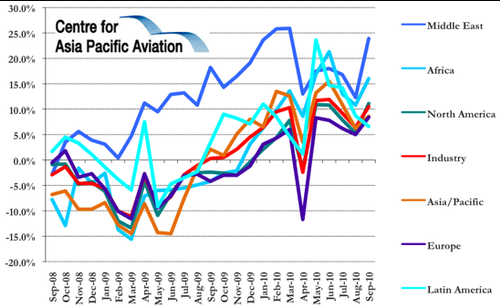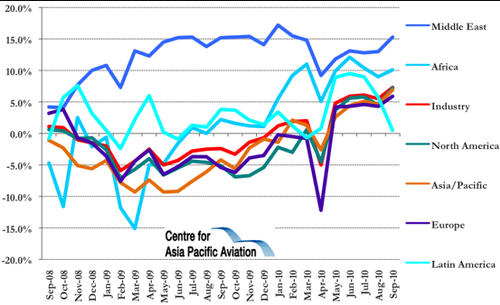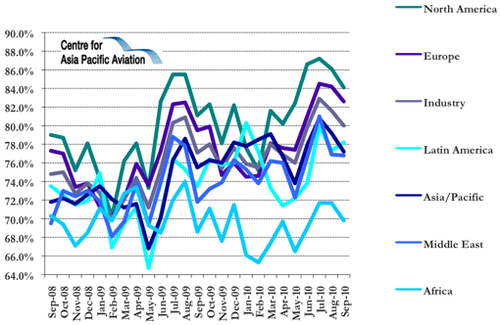'Mixed picture' for traffic in Sep-2010: stronger air travel, weaker freight volumes
IATA reported a strong rebound in international air travel in Sep-2010 from the softer numbers in Aug-2010. Air travel volumes (RPKs) increased 10.5% following a 6.5% increase in the previous month, however, there was a different picture in airfreight where volumes (FTKs) weakened more than expected although freight (FTKs) still remains 14.8% higher than Sep-2009 and level with the pre-crisis peak.
IATA stated: "Stronger air travel but weaker air freight volumes in September offers a very mixed picture of the situation in air transport markets. But air freight has usually been a good leading indicator. What happens next depends on the economy. Unless private spending steps in to replace the temporary boosts from fiscal stimulus and stock-building, the softness now evident in air freight could spread to air travel markets later in the year."
IATA traffic results: Sep-2009 vs Sep-2010 growth levels
|
RPK Growth |
ASK Growth |
PLF |
FTK Growth |
AFTK Growth |
FLT |
|
|---|---|---|---|---|---|---|
|
16.0% |
10.1% |
69.8% |
16.5% |
16.4% |
25.0% |
|
|
Asia/Pacific |
8.6% |
6.9% |
77.2% |
15.0% |
16.6% |
63.3% |
|
8.4% |
5.9% |
82.6% |
11.1% |
7.2% |
50.3% |
|
|
6.6^ |
0.5% |
78.2% |
21.3% |
0.9% |
48.8% |
|
|
23.9% |
15.3% |
76.8% |
24.0% |
17.5% |
46.1% |
|
|
11.1% |
7.2% |
84.1% |
13.0% |
8.2% |
42.9% |
|
|
10.5% |
7.3% |
80.0% |
14.8% |
11.9% |
52.4% |
Month-on-month traffic increase of 2%; second month of freight declines
On a month-on-month basis, international passengers grew 2.1% in Sep-2010 marking a robust rebound from the softer numbers seen in Aug-2010, particularly in the Middle East, partly a function of the timing of Ramadan which overlapped more in August than in September this year. Passenger capacity grew at a slower pace driving up load factors while freight traffic fell on a month-on-month basis representing the second successive month-on-month fall dipping back to the pre-recession peak.
IATA traffic results: Sep-2010 vs Aug-2010 growth levels
|
RPK Growth |
ASK Growth |
PLF |
FTK Growth |
AFTK Growth |
FLF |
|
|---|---|---|---|---|---|---|
|
2.9% |
1.0% |
1.3 ppts |
-3.9% |
-3.1% |
-1.9 ppts |
|
|
Asia/Pacific |
2.5% |
0.8% |
1.3 ppts |
-2.8% |
-0.5% |
-1.5 ppts |
|
0.5% |
-0.7% |
0.9 ppts |
-2.6% |
0.7% |
-1.7 ppts |
|
|
1.4% |
-2.3% |
2.8 ppts |
-3.2% |
-1.0% |
-1.0 ppt |
|
|
6.5% |
2.0% |
3.3 ppts |
1.4% |
2.2% |
-0.4 ppts |
|
|
2.5% |
1.0% |
1.2 ppts |
-1.6% |
-1.1% |
-0.2 ppts |
|
|
2.1% |
0.3% |
1.4 ppts |
-2.1% |
0.1% |
-1.2 ppt |
Comparing the level of traffic in Sep-2010 to that at the end of 1Q2010 shows an annualised average growth rate of just under 9%. This is slightly below the 10% average annualised growth recorded between the low point of the market in mid-2009 and the end of 1Q2010. Although this points to a modest slowdown in international air traffic growth, these rates are still well above trend despite softer economic conditions.
Traffic increases
During Sep-2010, traffic (RPKs) increased 10.5% following a 6.5% increase in Aug-2010 with capacity growth of 7.3%. Part of the year-on-year travel acceleration was due to a fall in Sep-2009. IATA reported there were some special factors such as the timing of Ramadan which accentuated the volatility between the months, but growth in all regions suggests last month's weakness was the normal volatility seen in travel patterns.
IATA airlines RPK growth by region: Sep-08 to Sep-2010
IATA airlines ASK growth by region: Sep-08 to Sep-2010
Passenger load factors spike; freight weakens
After reaching a peak of 79% on a seasonally adjusted basis in Feb-2010, passenger load factors had slipped back to 77.5% by Aug-2010 as capacity began to rise faster than demand this year. However, load factors in September have spiked to a seasonally adjusted 78.9% - back to the peak seen earlier this year - as capacity growth was exceeded by traffic growth. However, IATA warned that there is volatility in load factor data, stating the "higher load factor level may not persist over the months ahead, especially if the broader trend seen this year of accelerating capacity combined with moderating traffic growth continues".
In the freight segment, a reduction in freight volumes combined with flat capacity resulted in a fall in the industry international freight load factor to 52.3% on a seasonally adjusted basis. The load factor is still above the average level seen in the years ahead of the recession of around 51%. However capacity addition in excess of the rate of demand growth will inevitably put downward pressure on load factors.
IATA airlines passenger load factor by region: Sep-08 to Sep-2010
Freight growth decelerates; level with pre-recession peak
International FTKs increased 14.8% in Sep-2010 although there was a deceleration in growth from the 19% seen in the annual August-August comparison with month-on-month comparisons also weaker. The level of traffic slipped 6% from a high point in May-2010 and level with the pre-recession peak.
The overall fall in industry freight volume over recent months is greater than expected following the very strong post-recession rebound. The decline has occurred as inventory-sales ratios have been restored to more normal levels with restocking activity tailing off. Trade growth has also been relatively flat since May-2010.
IATA airlines FTK growth by region: Sep-08 to Sep-2010
Regional patterns change
Regional patterns are now changing for air travel and freight. During 2009 airlines in Asia Pacific and Latin America reported very strong post-recession rebounds while Europe and North America lagged. However, since the start of 2010 the situation has reversed with a slowing of growth for Asia Pacific and Latin American airlines but some acceleration in traffic carried by European and North American airlines.
IATA passenger and freight growth analysis by region: Sep-2010
|
Region |
Passenger growth |
Freight growth |
|---|---|---|
|
African airlines ended the third quarter with Sep-2010 passenger traffic volumes 7% higher than the pre-recession peak and equal to the level seen in Jun-2010 when traffic was boosted by activity surrounding the football World Cup in the region. |
n/a |
|
|
n/a |
European airlines remain the only grouping still with volumes below the pre-recession peak seen in early 2008. Freight volumes for European carriers have been helped by renewed export activity in recent months but still remain 14% below pre-crisis levels. |
|
|
Traffic rebounded strongly during 2009 but growth has moderated this year. Comparing Jun-2010 and Sep-2010 traffic levels shows annualised growth of 6.3% and Asia Pacific remains the last region where airlines based there have yet to see traffic recover to, or grow beyond, the pre-recession peak of early 2008. International traffic for Asia Pacific airlines remains 2% lower than their previous peak. |
Sep-2010 volumes slipped back to pre-recession levels and, with their 44% share of international airfreight traffic, this has been a key driver of the overall dip in the industry total volume. |
|
|
The bankruptcy of Mexicana has suppressed traffic growth for the Latin American year-on-year comparison given the cessation of operations. The impact of these factors is more evident on the Middle East and Latin America regional figures but also has a bearing on the volatility seen in the industry level indicator monthly and yearly comparisons. |
n/a |
|
|
The timing of Ramadan was earlier than in 2009 and dampened passenger growth in Aug-2010 while boosting it in Sep-2010, especially for Middle Eastern carriers. |
Seasonally adjusted freight traffic bucked the downward trend of the other regions to rise 1.4% over Aug-2010 levels. Increasing capacity and growing market share means airlines carried almost a third more freight traffic by the end of the third quarter than before the recession. |
|
|
North American airline international passenger traffic climbed back to pre-recession levels by September after posting annualised growth of 7.8% between the end of 2Q2010 and the end of 3Q2010. |
n/a |
Outlook: Traffic and profits to slow in 2011
Looking forward, growth will continue to slow, consistent with IATA's global industry outlook. The industry is now expected to post a profit of USD8.9 billion - up from the Jun-2010 forecast of USD2.5 billion - based on an exceptionally strong first half of the year. Meanwhile, much of what happens next is dependent on the economy



